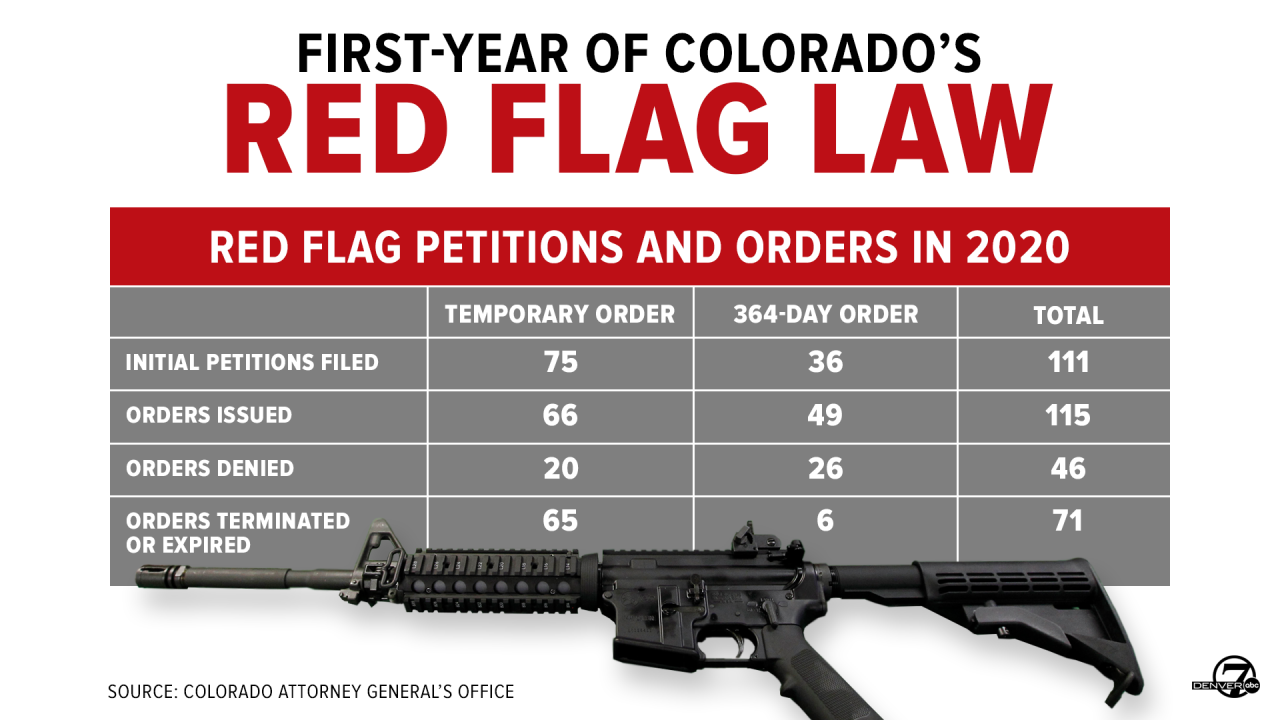What Is the Red Flag Law Colorado
![items.[0].image.alt](https://ewscripps.brightspotcdn.com/dims4/default/43d4b26/2147483647/strip/true/crop/5370x3021+0+179/resize/1280x720!/quality/90/?url=http%3A%2F%2Fewscripps-brightspot.s3.amazonaws.com%2F92%2Fe1%2F8d8813a147c198bce6a28d8a61c7%2Fap20137091849239.jpg)
(Copyright 2021 The Associated Press. All rights reserved. This material may not be published, broadcast, rewritten or redistributed.)
David Zalubowski/AP
Flags fly at half-staff in front of the dome of the Colorado State Capitol while it is illuminated in red light to remember the more than 1,000 people in the state who have died from the new coronavirus, Friday, May 15, 2020, in Denver. Buildings across the state were lighted red to coincide with a moment of silence at 7 p.m. (AP Photo/David Zalubowski)

A new report details how Coloradans called on the red flag law in 2020 — its first year as a law — and how often courts approved orders to remove a firearm from a person's possession if they were threatening violence to themselves or others with it.
The Colorado Attorney General's Office released the report on Wednesday morning. It examines the first year of the state's Deputy Zackari Parrish III Violence Prevention Act, commonly known as the red flag law, which took effect on the first of the year in 2020. It allows a judge to issue an Extreme Risk Protection Order (ERPO) to prohibit a person from possessing a firearm if the individual poses a risk to themselves or others for up to 364 days. A temporary order may be granted before a hearing, but cannot exceed 14 days.
Colorado Gov. Jared Polis signed the bill into law on April 12, 2019, and said he expected it to be used about 100 or 150 times per year — similar to states that had previously passed similar laws. Rep. Tom Sullivan, D-Centennial, cosponsored the extreme risk protection order bill. His son, Alex, was 27 years old when he was killed in the 2012 Aurora Theater shooting.
According to the report, the Colorado Department of Law found that petitioners called on the red flag law about 100 times in 2020, and most of those were filled by law enforcement officers. Of those filed by law enforcement, 85% resulted in orders lasting the maximum 364 days, according to the report. In fewer cases — more than 30 — families and other household members turned to the red flag law for intervention.
The petitions were filed in cases where an individual was threatening suicide, intimate partner violence, or mass violence, according to the report. Most of the petitions involved situations where the person was struggling with their mental health or substance abuse. One third of the petitions were filed after an individual made suicidal threats. Another third were filed after they threatened to harm others with a firearm, according to the report.
Here is a breakdown of the petitions filed in 2020, as detailed in AG Office's report:

Robert Garrison/KMGH
Courts granted the petitions that were filed by law enforcement at a "significantly higher rate" than those filed by family members or others living in the same household, the report found.
More than 30 petitions were filed by the latter, and of those, courts granted 364-day orders in six instances.
The report provided a breakdown of petitions that resulted in temporary orders and longer orders:
- 96% of petitions filed by law enforcement resulted in temporary orders
- 85% of petitions filed by law enforcement resulted in 364-day orders
- 32% of petitions filed by family or others in the household resulted in temporary orders
- 15% of petitions filed by family or others in the household resulted in 364-day orders
Judges did not issue orders where the petitions lacked evidence of a credible threat, or if the petition was filed in the wrong county.
After the bill was signed into law in 2019, leaders in about 35 Colorado counties passed resolutions in opposition to the red flag measure or declared themselves "Second Amendment sanctuaries" in an effort to stave off the law. Most of the concerns were over due process protections, the law getting misused, and possible violations of the Second Amendment.
Researchers at the Colorado School of Public Health found four instances of "clearly inappropriate attempted use of the red flag process" in an analysis of more than 100 petitions in 2020, according to the report. In every case, the person who filed the petition falsely characterized their relationship to the person. Each petition was denied.
In 2020, the Colorado Department of Law defended the constitutionality of Violence Prevention Act in two cases and was successful in both. The report details one of the cases, Gunnison Police Department v. Vallejo, where the district court said the act doesn't violate the Second Amendment "because it does not restrict law-abiding, responsible citizens from possessing arms." It notes the law only temporarily restricts the right.
Multiple other Colorado courts and courts in other states have reached the same conclusion for red flag laws, the report reads.
Looking ahead, the AG's Office recommends more education and outreach on how Coloradans, including law enforcement, can best use the law to prevent gun violence in their communities. More research and data analysis can help stakeholders understand the implications of the law, since red flag laws are relatively new in many states.
Attorney General Phil Weiser said the extreme risk protection orders in the law are a "vital tool" for this.
"Expanding our education, awareness, and training efforts on the protection order process can help save lives," Weiser said. "We look forward to continuing our strong partnerships with agencies statewide to ensure we effectively use the tools we have to prevent suicide and gun violence while protecting the rights of lawful gun owners."
You can read the full report below:
First Year Implementation of Colorado Violence Prevention Act by Denver7 on Scribd
Copyright 2021 Scripps Media, Inc. All rights reserved. This material may not be published, broadcast, rewritten, or redistributed.
The Morning Headlines, sign up for a mix of what you need to know to start the day in Colorado, picked for you.
What Is the Red Flag Law Colorado
Source: https://www.thedenverchannel.com/news/local-news/colorados-red-flag-law-attorney-generals-office-details-breakdown-of-petitions-filed-in-2020